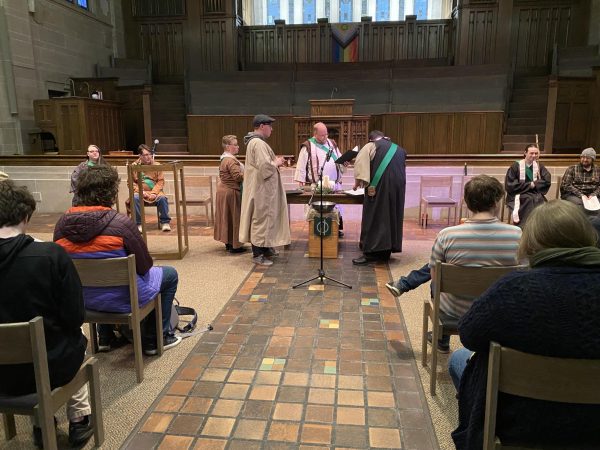On Sunday, Jan. 28, the Carleton and Oakdale Groves of the Reformed Druids of North America (RDNA) hosted a service in the chapel to commemorate the holiday of Imbolc, a holiday commemorating the midpoint between the winter solstice and the spring equinox that celebrates the coming of the first signs of spring.

As the Archdruid of the Oakdale Grove in the Twin Cities John Martens, otherwise known as John the Verbose, explained it, Druidry has a rich history that is inseparable from Carleton’s history. The Carleton Grove was the brainchild of a group of students in 1963, when the administration required that during each ten-week term, students needed to attend seven chapel services or equivalent religious events. The Druids were formed as a way to sidestep this mandate, and even though they wrote several anthologies and planned many events, the group was supposed to be only temporary and planned to disband when the religious observance requirement was lifted.
But when Carleton did away with the mandate in the spring of 1964, many members of the Druids expressed their desire to continue to meet, as they found spiritual meaning in the nature-centered practice. Thus, Druidry at Carleton did not end there and as students graduated and went off to graduate programs and careers around the country, they started Groves in their new homes. Soon, modern or “reformed” Druidry had become a worldwide phenomenon, and Martens estimated that the religion has several thousand members. The Carleton Grove, led by Austin Skoda ’25, is still active and meets weekly. Skoda is considered the Archdruid of all reformed Druidry, but long-serving members of the Carleton and Oakdale Groves are also available for support.
After John the Verbose gave a history of Druidry and Imbolc as an ancient and reformed Druid holiday, he sounded a Carynx in all four cardinal directions. A Carnyx is a metal wind instrument that is in the shape of an elongated letter “s” with an animal head-shaped bell on the end. Skoda, the Archdruid, and John, the Preceptor or clerk of the Grove, then said several invocations in a call-and-response format. They spoke about the purpose and the lessons of Imbolc, saying, “In the heat of winter’s embrace, Imbolc whispers its arrival. The first thaw beckons, and beneath the snow, life stirs, a silent promise of renewal.”
The Druid values of understanding and reflection were demonstrated in the Centering and Declaration of Goals rituals. As a candle was lit, Skoda encouraged “each of us [to] now go to the sacred place, to the sanctum of Divinity… evaluating all that has happened in our private lives since last we stood together, so that the secret essence may help us to understand… as sources of wisdom and growth… like a spark of the sun and a flame within the heart of every being.”
An offering was prepared “to those whom we wish to honor.” Before an offering of plant material was given, one Druid named Edward gave the offer of “the bardic arts” in the form of a song and the Bard led the attendants in a hymn to the Earth Mother. Then, a sacrifice of evergreen branches, plant-based milk and consecrated water called “the Waters-of-Awakening” was performed. Each ordained Druid had a cup of water, and once Skoda declared it to be the Waters-of-Awakening, they took a drink and poured the rest into the dish of offering. While ancient Druids performed sacrifices of animals, reformed Druids only sacrifice plants. Evergreen wood was used for this particular offering because the Druids “have taken the evergreen as a sign and the evergreen do we consecrate to ourselves… as surely we see the returning sun, day by day.” During this offering process, three candles were lit.

At this point in the service, those in attendance had the opportunity to join the Druid Order of the Acorn and become members of the religion. One person from the Twin Cities and two chapel attendants stood before the congregation to be ordained. John the Verbose gave them each an acorn, and after they agreed to enter into Druidry and “engage in activities interwoven with their own desires and their own truths,” they each placed their acorn into the offering dish to symbolize their new commitment to the practice.
The service concluded with one minute of silent meditation. According to John the Verbose, “Reformed Druid custom places a strong emphasis on meditation as the means of searching for spiritual fulfillment. There are dozens of ways to meditate, and as Druids we are encouraged to find what works best for us… with the hustle and bustle of the 21st century, we never really deliberately schedule any amount of time to sit still and do absolutely nothing except ponder the moment.”
After the meditation was complete, each of the lit candles were extinguished and a closing benediction was read. The service was followed with dinner from Desi Diner served in the rear vestibule of the chapel.
The event was moderately well-attended, with students from both Carleton and St. Olaf observing the holiday, including those who are regular attendants of RDNA meetings. “The Druids are a nice community,” said Maddy Sriver ’27. “I have a lot of laughs and I like spending time with them.”
Imbolc was also a way for those who had never interacted with the Druids to observe their rituals for the first time, as Druid events normally happen within the nucleus of the Carleton Grove organization. “This is the first Druid service that we have ever hosted at the chapel. It was a really cool experience… to see the Druid rituals and all of the importance the Druid leaders placed on that,” said Sophie Stein ’26, a Chaplain’s Associate. “It was really interesting to hear some of the history of Druids at Carleton and some of the conflicts with the Druids, and also to realize how important Carleton is to the whole Druid community even though it has branched out onto every continent. Our Grove at Carleton is still like the ‘motherland’ and the leader of the Carleton grove is the leader of the Druids but is a student by nature.”












